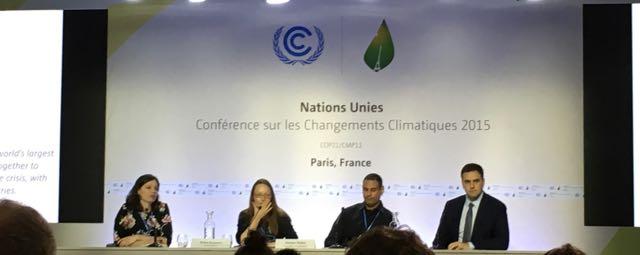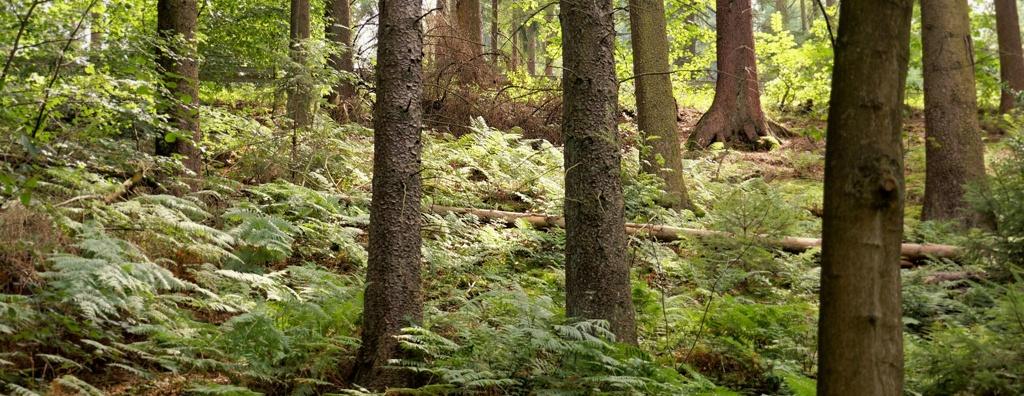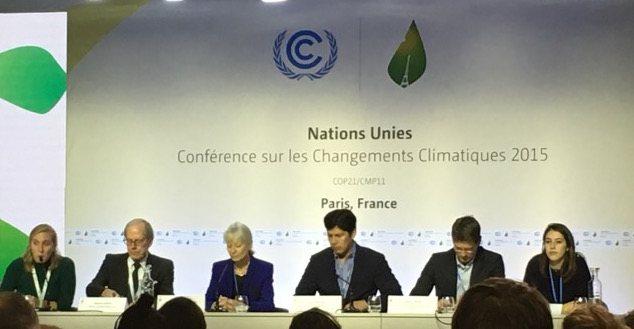(Image: Al Gore addresses U.N. Secretary-General Ban Ki-moon.)
Former U.S. Vice President Al Gore took to the stage at COP21 on Thursday in a side-event focused on stranded fossil fuel assets. The crowd expected the longtime climate activist to come prepared with a compelling narrative that made the case for strong action coming out of the conference—and Gore did not disappoint.
In a 20-minute speech, he laid out the many forces at play in the climate crisis and the solutions being presented by scientists, activists and indeed by the market itself.
He pointed to catastrophic downpours, flooding and mudslides happening now in Chennai, India, which stalled the publication of The Hindu newspaper for the first time since the 19th century, along with ongoing and historic droughts in California, the Korean peninsula and much of southern Africa.
"Indeed, the television news every evening is like a nature hike through the book of Revelation," he punctuated, with flair befitting of a former presidential candidate.
And while Gore pulled no punches with regard to the severity of the climate crisis, he acknowledged the road ahead will not be an easy one—and seemed to almost call for patience from the environmental community, which is surely ironic considering he's been warning the world of these issues for over 15 years:
"For 150 to 200 years, we have relied on carbon-based fuels for the dramatic progress in global civilization, and to this day more than 80 percent of all the energy used in the world economy still comes from carbon-based fuels," Gore declared. "And all of us must acknowledge what a daunting task lies ahead in making the switch to a low-carbon economy. It's bound to be filled with challenges; it already is."
Bullish on Paris
Gore is no stranger to COP proceedings. He's attended a number of them in years past and is even known for "stalking" attending delegates in the corridors of power, as Nick Nuttall, head of communications and outreach for the United Nations Framework Convention on Climate Change (UNFCCC), fondly described in his introduction.
But, although Gore has witnessed the lead-up and disappointment surrounding former COP proceedings, he appeared bullish that Paris will end differently:
"One of the dramatic differences in the reality we are living in—in these days of the Paris conference, compared to previous conferences—is that the business community, investors, technology developers, researchers and others have brought the technologies of solar photovoltaics, wind power, efficiency in a variety of different forms, battery storage, sustainable forestry and sustainable agriculture to the point where these new approaches are extremely competitive with the legacy approaches that we are quite used to."
He pulled several examples from current events to illustrate his point:
Goldman Sachs reports big gains in solar and wind: Entitled The Low-Carbon Economy, this new report's name alone is enough to raise eyebrows coming from a source like Goldman Sachs, but the findings are even more surprising. The financial group predicts that, between 2015 and 2020, solar photovoltaics and onshore wind will add more to global energy supply than U.S. shale oil production did between 2010 and 2015. "Those of you who pay attention to the energy markets," Gore said, "know what an incredibly powerful development for energy markets was caused by that sudden addition of fractured gas."
Renewable energy shatters predictions: In 2000, the best predictions available for advances in wind energy forecast that the world would generate 30 gigawatts of wind power by 2010, Gore explained. We exceeded that prediction 12 times over. In 2002, analysts predicted we would add 1 gigawatt of solar energy per year by 2010. We exceeded that prediction 17 times over. Last year it was exceeded 48 times over, and this year it will be exceeded 62 times over. "That is an exponential curve," Gore said.
Utilities offer free power with renewables: "It's not only the exponential cost-down curve associated with renewable energy, which is having such a powerful impact that was unexpected for so many," Gore said, "it is also the nature of this resource -- it has zero marginal cost." That, he continued, is what led TXU—an investor-owned utility in Texas—to introduce a renewable-based rate plan that made electricity free for customers during non-peak hours (between 9 p.m. and 6 a.m.). Similar rate structures are also being used in south Australia, Gore said.
Two U.S. states hold open competition for energy generation: Two U.S. states, Minnesota and Colorado, recently ran a transparent, open competition for the provision of new electricity generation, Gore said. In both cases, it came down to competition between gas-fired generation and solar photovoltaics.
Solar sells for less than 4 cents per kilowatt-hour in Nevada: Warren Buffet recently signed a contract purchasing new electricity from photovoltaics for 3.87 cents per kilowatt hour. Gore called this "a figure that was just stunning to many who thought we might never get there."
A warning to investors
Gore then posed a question to the audience, "Will we change?"
"That's what Paris is all about. But the answer that will come here in Paris will come not only from the final text of an agreement that the national governments will sign, but from the business community, from the NGOs and from the investor community.
"Investors need to look at the pattern that is unfolding, lest they be trapped holding stranded assets."
Gore doubled-down on his warning to investors, comparing stranded fossil fuel assets—which a new report from the think-tank Carbon Tracker pegged at $2.2 trillion—to the catastrophe of sub-prime mortgages that caused the Great Recession, from which the world is still struggling to emerge.
"They decided in the banking community that the traditional reluctance to give mortgages to people who could not make a downpayment and had no ability to make monthly payments could be circumvented if you just got millions of them, lumped them together, securitized them with some illusory financial instrument, and then bundled them and sold them into the global market," Gore summarized, to knowing and somewhat cynical snickers from the audience. "It turned out that that illusion was punctured when reality intervened and a few, and then many, noticed that it was a complete scam. And suddenly those assets were stranded.
"There are now trillions of dollars of stranded carbon assets, and there are illusions which levitate the assertion that the value is much higher than it really is. There are active efforts to fool investors."
Gore then pointed to the recent announcement from New York Attorney General Eric Schneiderman that he will open a criminal investigation against ExxonMobil for actively misleading investors into believing that no one needs to worry about the climate crisis. "Well, they do," Gore said flatly.
A bold agreement coming out of Paris—as well as state, local and regional action undertaken in places like California, Quebec and the European Union—could lead to additional stranded fossil fuel assets, Gore pointed out. And as consumers continue to wise up to the gravity of the climate crisis, fossil fuel companies are faced with even greater risk.
"Many of the carbon companies are in danger of losing their public license to operate, as more and more people realize that we simply cannot continue putting 110 million tons of global warming pollution into the atmosphere, as if it is an open sewer, every single day."
Many large institutional investors are already coming to this realization, as fossil fuel divestment commitments reach $3.4 trillion. And Gore predicts this trend will continue, with investors divesting "first from the riskiest carbon assets, and over time from all [of the assets] that look as if they are in danger of being stranded" and then investing "in the fantastic new opportunities that are emerging in the low-carbon economy."
The proverbial mic-drop
To close his speech, Gore stared into the the camera lens only a few feet from his pulpit and took aim at laggard global politicians, with a line that likely left them shaking in their Gucci loafers.
"I would close by saying that for anyone who doubts that we have the political will to act, please remember that the will to act is itself a renewable resource."
Well said, Mr. Gore. Well said.
Image credit: Flickr/United Nations Photo




















